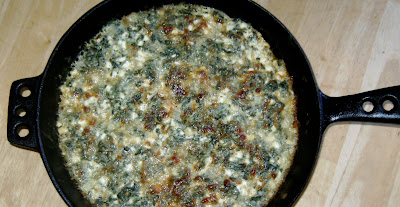 We had been planning since last Passover to post this recipe around now, reasoning that you'd be most interested in Seder recipe ideas right before the big day. Now that it's finally posting time, we want to dedicate this post to Hannah's Grandma Olga, an amazing cook and a fabulous lady who passed away earlier this month. While she never used the internet and thus never read the blog, she has been such an inspiration for our work: Grandma Olga was all about making things from scratch with the best produce she could find, and her recipes are behind many of our posts, like date charoset, mjeddra and fried eggplant. We feel so lucky to have inherited her recipe journal, a 1964 date book packed with her own handwritten recipes, recipe cards from relatives, recipes clipped from the newspaper, recipes from the back of a Quaker Oats box. There is no time of the year I associate with Grandma Olga more so than Passover, when she would to make jars of her famous date charoset for all the households in our family, lemony-minty hamud that perfumed the whole house, and perfectly-tanned hamine eggs. So Grandma Olga, this one's for you.
We had been planning since last Passover to post this recipe around now, reasoning that you'd be most interested in Seder recipe ideas right before the big day. Now that it's finally posting time, we want to dedicate this post to Hannah's Grandma Olga, an amazing cook and a fabulous lady who passed away earlier this month. While she never used the internet and thus never read the blog, she has been such an inspiration for our work: Grandma Olga was all about making things from scratch with the best produce she could find, and her recipes are behind many of our posts, like date charoset, mjeddra and fried eggplant. We feel so lucky to have inherited her recipe journal, a 1964 date book packed with her own handwritten recipes, recipe cards from relatives, recipes clipped from the newspaper, recipes from the back of a Quaker Oats box. There is no time of the year I associate with Grandma Olga more so than Passover, when she would to make jars of her famous date charoset for all the households in our family, lemony-minty hamud that perfumed the whole house, and perfectly-tanned hamine eggs. So Grandma Olga, this one's for you.Hard-boiled eggs are a traditional fixture on the Passover Seder plate. The Syrian-Jewish version, hamine eggs, involves slowly cooking the eggs overnight with onion skins and coffee grounds, which turns the flesh a beautiful tan color. Last year, we started to make hamine eggs for Passover and realized that while we had plenty of onion skins, the tiny bag of 2-year-old coffee in the freezer had vanished. We did, however, have a box of lapsang souchong tea bags and decided to try them instead. Lapsang souchong is a smoked black tea with an amazing flavor, and our finished eggs were deliciously rich and smoky. Throw these on your Seder plate and everyone will be hooked!
This does take a while, but nearly all of the time is inactive and you can either do this overnight or try it in a Crock-Pot if you don't feel like being confined to your house for 6-8 hours.
12 eggs
Skins from 3-5 onions
10 Lapsang Souchong tea bags
1 teaspoon canola oil
Place eggs in a large saucepan and cover with cold water. Add the onion skins, tea bags and oil and bring to a boil, then reduce heat to very low. Simmer, partially covered, for 6-8 hours. Any cracks in the eggshells will create beautiful dark veins on the egg whites. Drain the eggs, discard the tea bags and onion skins, and peel the eggs once they've cooled.



